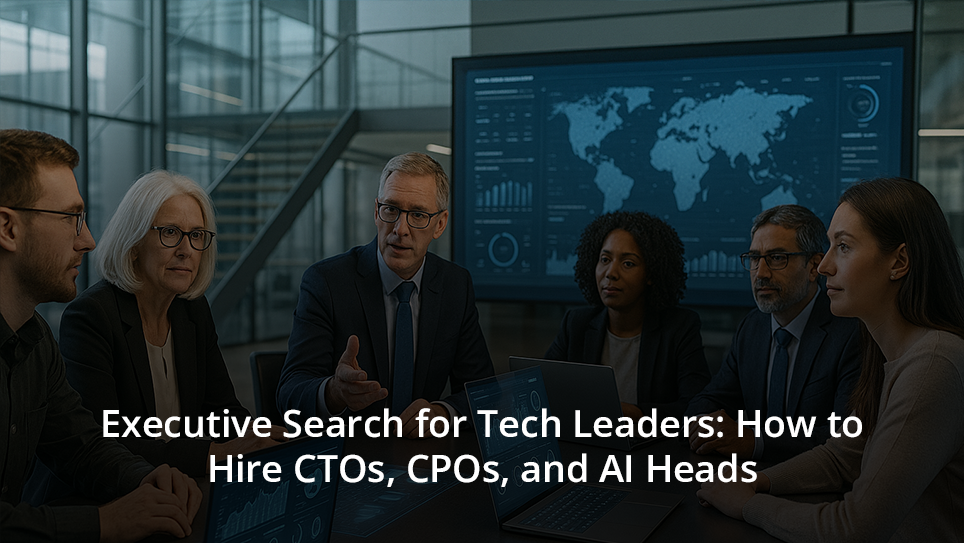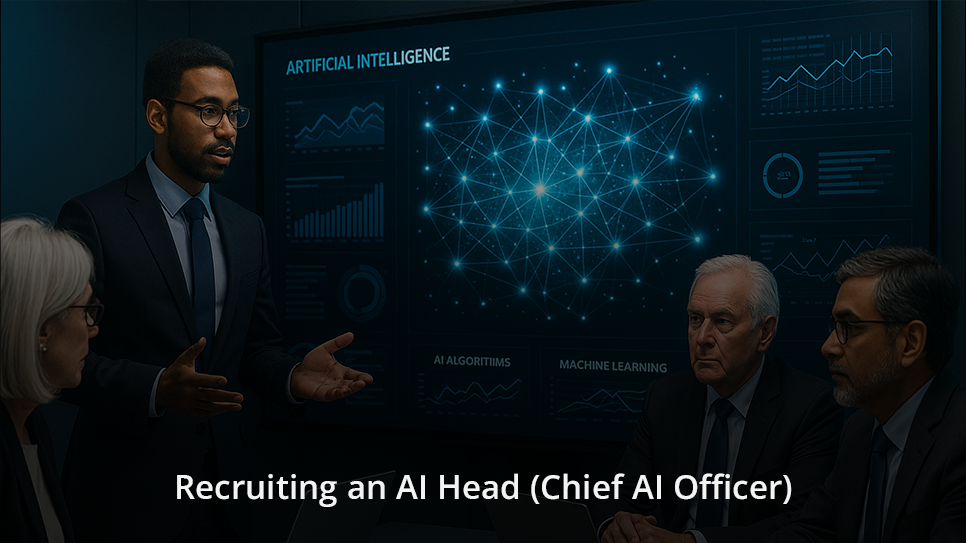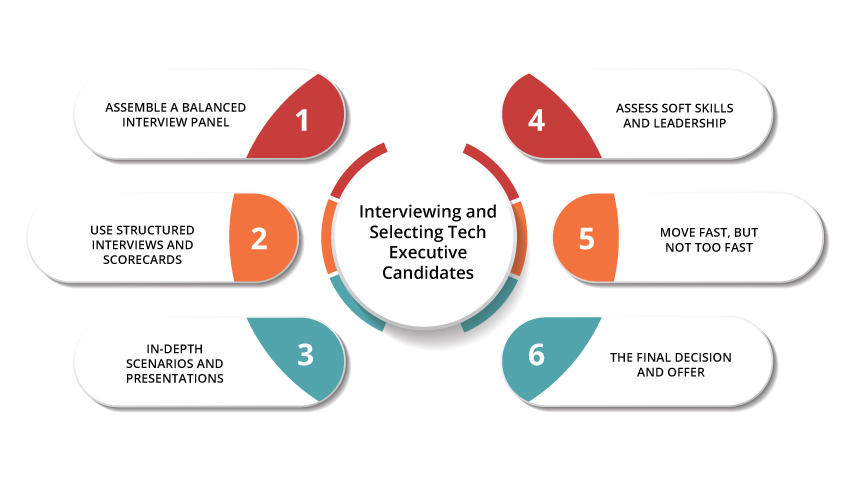Executive Search for Tech Leaders: How to Hire CTOs, CPOs, and AI Heads

Hiring top technology executives is a make-or-break decision for any tech-driven company. Whether you’re hiring a CTO, bringing on a Chief Product Officer (CPO), or recruiting a Head of AI, these roles shape your product vision and drive innovation. In fact, the senior-most tech executive often sets the technical vision and can be “the difference in the race to deploy effective AI or launch a successful product,”. Great tech leaders also attract top talent, influencing your company’s culture and long-term capabilities.
However, the executive search for tech leaders can be complex. Demand for skilled CTOs, CPOs, and AI leaders is fierce, and mistakes in hiring can stall your growth. This guide will walk you through a tech leadership recruitment strategy, from defining each role and searching globally, to interviewing and onboarding, so you can confidently find the right technology executives for your organization.
Hiring a CTO: Process and Best Practices
The hiring a CTO process starts with clarity. Decide whether you need a CTO, VP of Engineering, or technical co-founder. A CTO sets tech strategy and links it to business outcomes, while a VP of Engineering focuses on execution and delivery.
What to look for: Prior experience at your growth stage, ability to scale teams, domain expertise, and a track record of attracting and retaining top talent. A great CTO blends technical credibility with strategic vision and leadership.
Finding candidates: Use referrals from investors, advisors, and peers, but also consider an executive search firm for CTO roles to access vetted, passive candidates quickly.
Global search: Don’t restrict by location. Remote or fractional CTOs can be cost-effective and bring global expertise. FX31 Labs’ Remote CTO services, with presence in the USA and India, highlight how global searches open new talent pools.
Evaluating candidates: Run a structured interview with input from the CEO, technical leads, and possibly investors. Test technical depth, leadership skills, and cultural fit. Keep the process efficient (around one month) and check references thoroughly.
Hiring a CPO: Best Practices for Product Leadership
A Chief Product Officer (CPO) owns product vision, strategy, and execution, turning customer needs and business goals into a roadmap. Many founders lead product early, but as complexity grows, a dedicated CPO ensures focus and prevents growth plateaus.
What to look for:
- Strategic vision & execution – proven record of owning roadmaps and driving business growth.
- Leadership & communication – ability to align cross-functional teams and evangelize the product.
- Data-driven mindset – comfort with metrics, testing, and modern tools like AI insights.
- Customer focus – deep understanding of user needs and translating feedback into product value.
- Timing: Often beneficial by pre-Series A if product complexity is high. Offer competitive compensation (equity included) and a clear mandate to attract top talent.
- Finding candidates: Tap your investor/founder network, target leaders behind products you admire, and consider executive search specialists to access proven product leaders beyond your immediate reach.
Recruiting an AI Head (Chief AI Officer)

With AI central to competitive advantage, more firms are hiring Chief AI Officers (CAIOs) or Heads of AI to shape AI strategy and manage generative AI risks. If AI drives your product or operations, a senior AI leader ensures you stay ahead.
Role & importance: The AI Head defines your AI roadmap, aligns it with business goals, oversees data infrastructure, and ensures compliance with ethics and regulations. They also attract top AI talent, making them the strategic brain of your AI initiatives.
How to recruit: Seasoned AI leaders are scarce, so offer a compelling vision. Search globally across AI labs, research communities, and industry groups. Engage executive search firms specializing in AI if needed.
What to assess: Look for strong ML foundations and proven business outcomes (e.g., AI that boosted retention or cut costs). Evaluate strategic thinking and ability to stay current with fast-moving AI trends.
Best practices: Set clear expectations for resources, budget, and team-building. Decide reporting lines (CTO vs. CEO) based on how core AI is to your business. If not ready for a full-time hire, a generative AI consulting company can bridge the gap until you find the right leader.
Crafting a Tech Leadership Recruitment Strategy
Hiring tech executives requires a strategic approach. It’s not a process you should rush or leave to chance, given the stakes. Here are key elements of a solid tech leadership recruitment strategy:
- Define success upfront: Before you even start contacting candidates, define what a successful hire looks like. Outline the top objectives for the role. This clarity feeds into a strong job description that will guide the search.
- Leverage multiple channels: Cast a wide net. Use professional networks (LinkedIn, industry conferences, angel investor communities) and let it be known quietly that you’re seeking a tech leader.
- Target passive candidates: The best tech leaders are often not actively job-hunting. Your strategy should include courting candidates who are currently successful elsewhere.
- Sell the opportunity: Recruiting senior talent is a two-way street; you must convince them that your company is the next exciting challenge. Be ready to articulate your vision, growth story, company culture, and the autonomy or impact the executive will have.
- Consider cultural and geographical fit: If your company operates across regions or focuses on certain markets, seek leaders with relevant experience.
- Prioritize diversity: Diverse leadership teams tend to foster more innovation and better performance. Make an intentional effort to include candidates from underrepresented backgrounds in your search.
Interviewing and Selecting Tech Executive Candidates

Once you have a slate of promising candidates, a structured interview and selection process is critical. Here are the best practices for interviewing for tech executive roles:
- Assemble a balanced interview panel: Involve a mix of stakeholders to evaluate the candidate from different angles. Each person on the panel should have a defined focus area (culture fit, technical depth, leadership style, etc.) to avoid overlap and cover all bases.
- Use structured interviews and scorecards: Define the key competencies and criteria beforehand, for example, “scaling engineering teams,” “product innovation,” “strategic thinking,” “communication skills,” etc. Provide an interview scorecard for panelists to rate candidates on these attributes.
- In-depth scenarios and presentations: It’s common to ask tech executive candidates to present a brief strategy or complete a case exercise. For a CTO, you might pose a scenario like, “Our platform needs to handle 10x traffic next year. How would you approach this scaling challenge?” For a CPO, maybe, “Evaluate our product and name two features you’d prioritize in the next 6 months and why.”
- Assess soft skills and leadership: Technical acumen alone isn’t enough for these roles. During interviews, probe their leadership philosophy. Ask about times they had to make a tough call or how they managed a failing initiative.
- Move fast, but not too fast: As mentioned, senior candidates are often weighing multiple opportunities, so keep momentum. Try to schedule interviews close together. Aim to decide quickly once interviews conclude.
- The final decision and offer: Bring the panel together for a debrief to share notes and reach consensus. If there’s doubt on any critical aspect, it may warrant another discussion or even an additional interview.
Conclusion
In today’s innovation-driven landscape, having the right technology leadership is crucial. An effective executive search for tech leaders will ensure you hire visionaries who also excel at execution, be it a pioneering CTO to steer your engineering, a dynamic CPO to craft winning products, or a savvy AI Head to unlock data-driven opportunities. By following best practices in defining roles, casting a wide net (across regions and industries), and running a thoughtful interview process, you can significantly increase your chances of hiring a tech executive who propels your business forward. Remember, these hires will shape your company’s future for years to come. Invest the time and resources into getting it right, and the payoff will be seen in innovation, growth, and competitive edge.
Looking to hire your next CTO, CPO, or AI Head?
Partner with FX31 Labs for an executive search process that delivers global tech leaders aligned with your vision.
FAQs
Q1. What is the difference between a CTO and a VP of Engineering?
A CTO drives technology vision and aligns it with business strategy, while a VP of Engineering focuses on execution, team management, and delivery. Startups may combine both roles early, but usually separate them as they grow.
Q2. When should a startup hire a Chief Product Officer (CPO)?
Most startups bring in a CPO by Series A, especially if product decisions are bottlenecked by the founder or customer needs outpace delivery. A CPO ensures focused product strategy and avoids growth plateaus.
Q3. How do we recruit a Head of AI?
Offer compelling AI challenges, resources, and vision. Target AI communities, labs, or global hubs, and consider interim support from a generative AI consulting company. Look for leaders with both ML expertise and business impact.
Q4. Should we use an executive search firm for CTO or CPO hires?
Yes, if your network is limited or the role is critical. Search firms bring vetted candidates, market insights, and save time. While costly, they’re valuable for confidential or urgent searches.
Q5. How do we ensure a smooth interview process?
Plan structured stages, use scorecards, and involve both technical and business stakeholders. Keep timelines tight (3–4 weeks), add case exercises, and maintain clear communication to secure top candidates.
